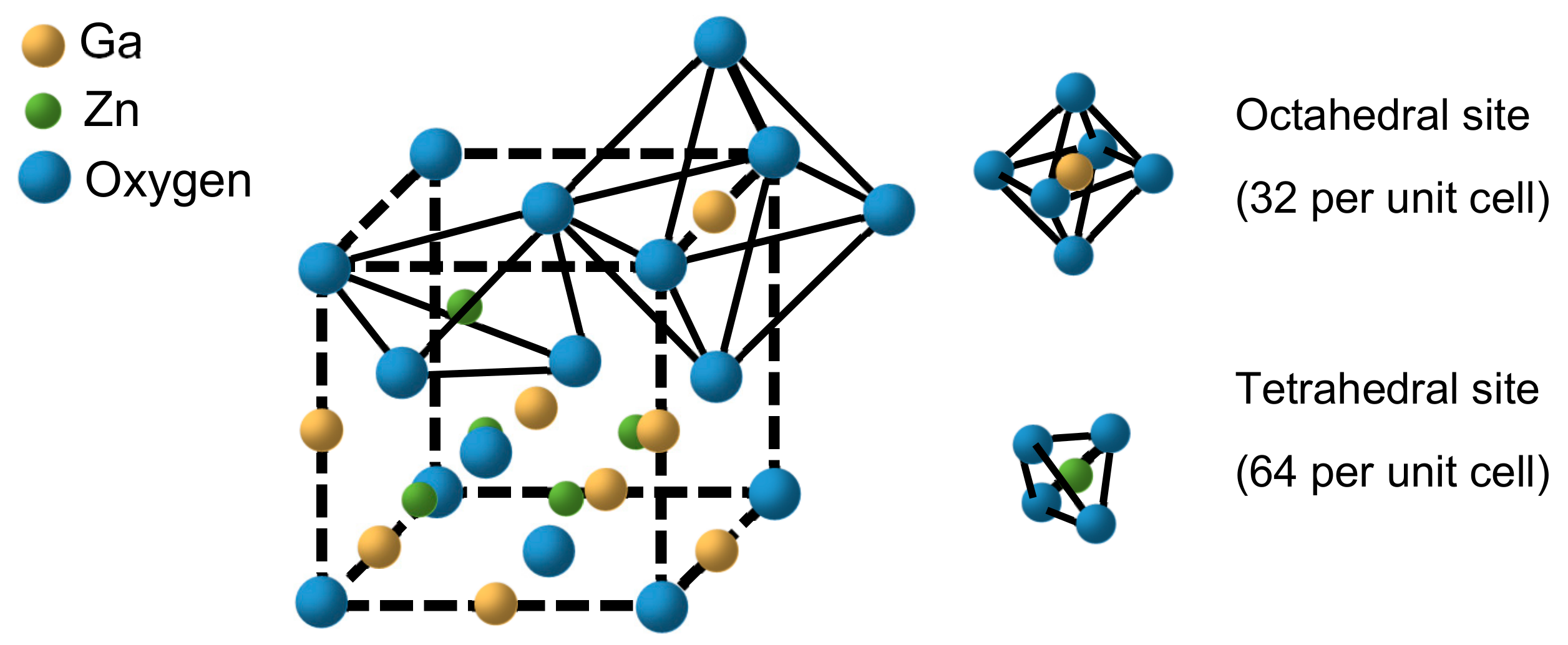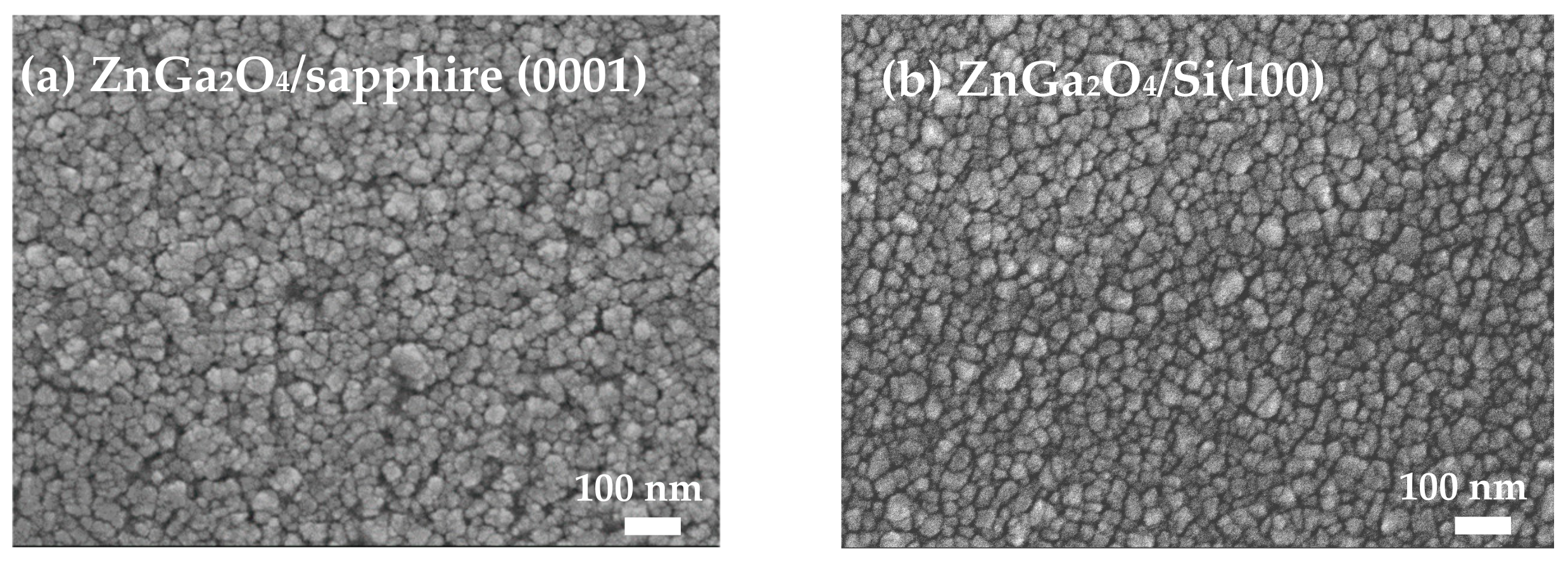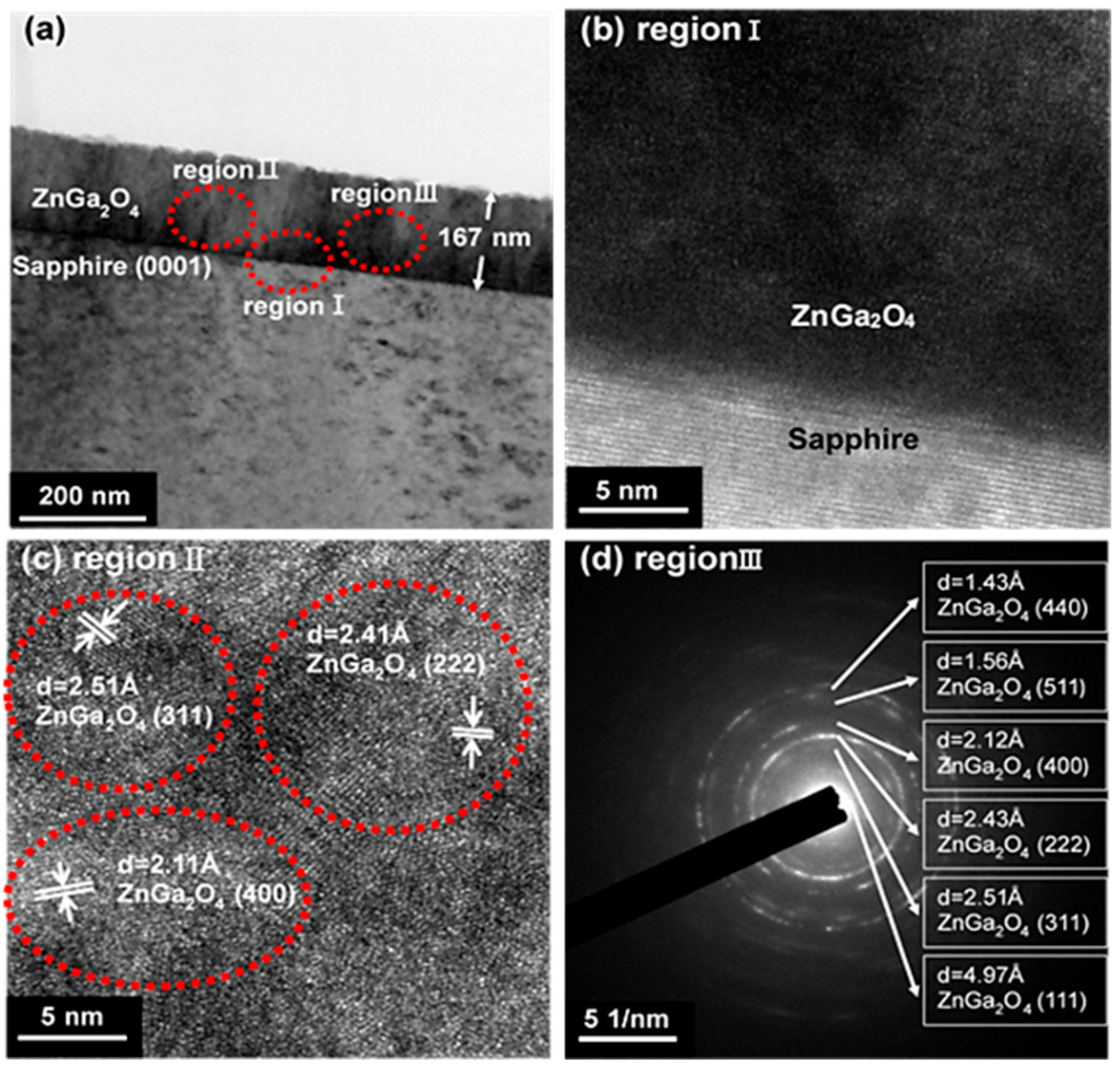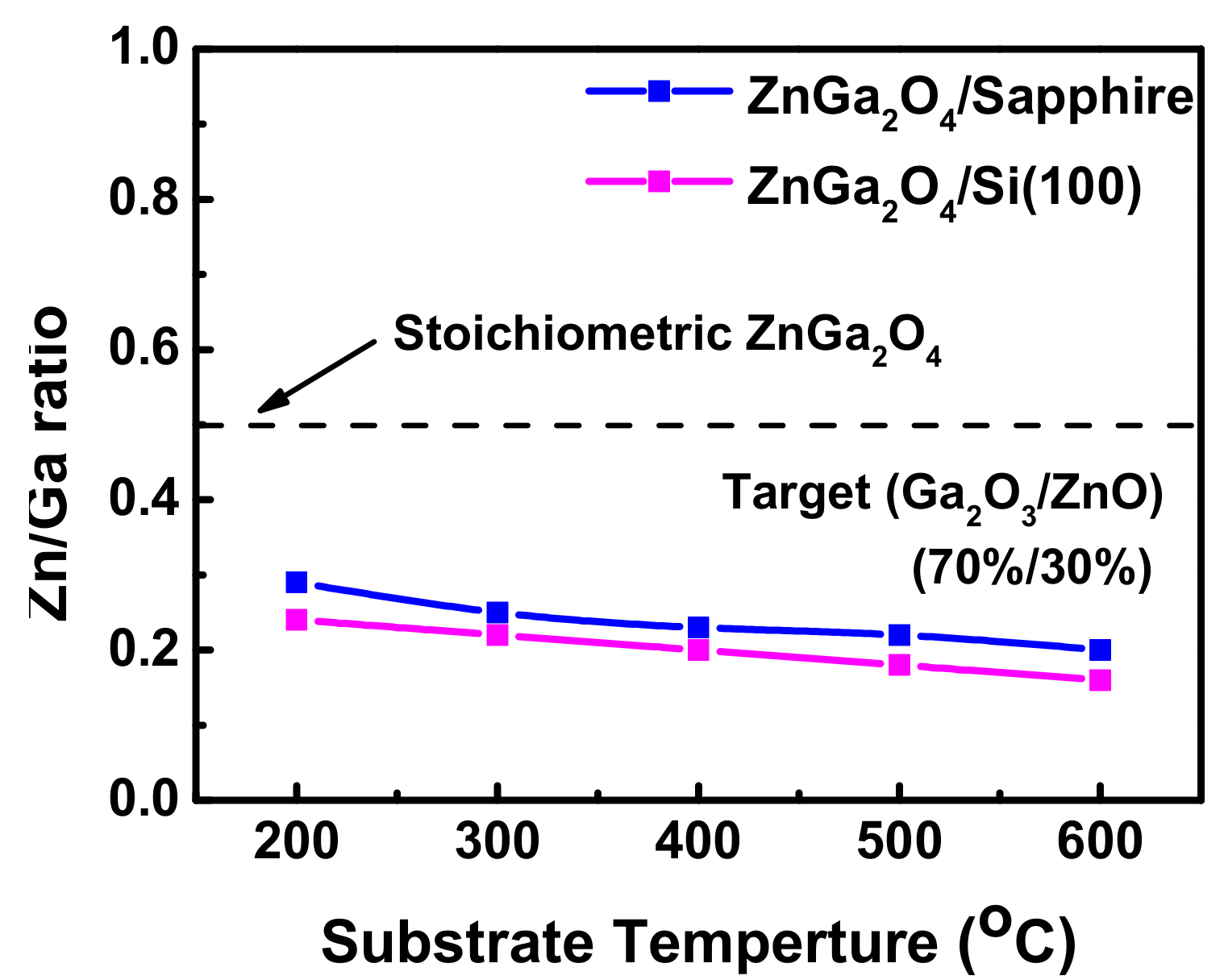Structural Characteristics and Photoluminescence Properties of Sputter-Deposition ZnGa2O4 Thin Films on Sapphire and Si(100) Substrates
Abstract
:1. Introduction
2. Materials and Methods
3. Results and Discussion
4. Conclusions
Author Contributions
Funding
Acknowledgments
Conflicts of Interest
References
- Omata, T.; Ueda, N.; Ueda, K.; Kawazoe, H. New ultraviolet-transport electroconductive oxide, ZnGa2O4 spinel. Appl. Phys. Lett. 1994, 64, 1077–1078. [Google Scholar] [CrossRef]
- Itoh, S.; Toki, H.; Sato, Y.; Morimoto, K.; Kishino, T. The ZnGa2O4 phosphor for low-voltage blue cathodoluminescence. J. Electrochem. Soc. 1991, 138, 1509–1512. [Google Scholar] [CrossRef]
- Vecht, A.; Smith, D.W.; Chadha, S.S.; Gibbon, C.S.; Koh, J.; Morton, D. New electron excited light-emitting materials. J. Vac. Sci. Technol. B 1994, 12, 781–784. [Google Scholar] [CrossRef]
- Tran, T.K.; Park, W.; Tomm, J.W.; Wagner, B.K.; Jacobsen, S.M.; Summers, C.J. Photoluminescence properties of ZnGa2O4: Mn powder phosphors. J. Appl. Phys. 1995, 78, 5691–5695. [Google Scholar] [CrossRef]
- Shi, Q.; Wang, C.; Zhang, D.; Li, S.; Zhang, L.; Wang, W.; Zhang, J. Luminescence of Cr3+ doped ZnGa2O4 thin films deposited by pulsed laser ablation. Thin Solid Films 2012, 520, 6845–6849. [Google Scholar] [CrossRef]
- Yan, J.L.; Zhao, Y.N.; Li, C. Formation of ZnGa2O4 films by multilayer deposition and subsequent thermal annealing. Chin. Phys. B 2014, 23, 048105. [Google Scholar] [CrossRef]
- Wang, W.W.; Zhang, J.Y.; Yuan, L.; Chen, Z.Y.; Wang, T.M. Preparation and optical properties of ZnGa2O4:Cr3+ thin films derived by sol-gel process. Appl. Surf. Sci. 2010, 256, 4702–4707. [Google Scholar]
- Horng, R.H.; Huang, C.I.; Ou, H.L.; Juang, T.K.; Liu, P.L. Epitaxial growth of ZnGa2O4: A new, deep ultraviolet semiconductor candidate. Cryst. Growth Des. 2017, 17, 6071–6078. [Google Scholar] [CrossRef]
- Reshmi, R.; Krishna, K.M.; Manoj, R.; Jayaraj, M.K. Pulsed laser deposition of ZnGa2O4 phosphor films. Surf. Coat. Technol. 2005, 198, 345–349. [Google Scholar] [CrossRef]
- Osorio-Fernandez, A.; Tapia, M.; Vazquez-Olmos, A.R.; Chavez, J. Enhanced luminescence properties of ZnGa2O4:Cr3+ nanoparticles with an average crystallite size of 5 nm. J. Solid State Chem. 2019, 269, 328–335. [Google Scholar] [CrossRef]
- Kumar, S.; Sarau, G.; Tessarek, C.; Gobelt, M.; Christiansen, S.; Singh, R. Study of high quality spinel zinc gallate nanowires grown using CVD and ALD techniques. Nanotechnology 2015, 26, 335603. [Google Scholar] [CrossRef] [PubMed]
- Liang, H.F.; Meng, F.; Lamb, B.K.; Ding, Q.; Li, L.S.; Wang, Z.C.; Jin, S. Solution growth of screw dislocation driven alpha-GaOOH nanorod arrays and their conversion to porous ZnGa2O4 nanotubes. Chem. Mater. 2017, 29, 7278–7287. [Google Scholar] [CrossRef]
- Wu, M.R.; Li, W.Z.; Tung, C.Y.; Huang, C.Y.; Chiang, Y.H.; Liu, P.L.; Horng, R.H. NO gas sensor based on ZnGa2O4 epilayer grown by metalorganic chemical vapor deposition. Sci. Rep. 2019, 9, 7459. [Google Scholar] [CrossRef] [PubMed]
- Tasi, S.H.; Basu, S.; Huang, C.H.; Hsu, L.C.; Lin, Y.G.; Horng, R.H. Deep-ultraviolet photodetectors based on epitaxial ZnGa2O4 thin films. Sci. Rep. 2018, 8, 14056. [Google Scholar]
- Shen, Y.S.; Wang, W.K.; Horng, R.H. Characteristics of metal oxide semiconductor field-effect transistors of ZnGaO grown on sapphire substrate. IEEE J-EDS 2017, 5, 112–116. [Google Scholar]
- Baptista, A.; Silva, F.; Porteiro, J.; Miguez, J.; Pinto, G. Sputtering physical vapour deposition (PVD) coatings: A critical review on process improvement and market trend demands. Coatings 2018, 8, 420. [Google Scholar]
- Horng, R.H.; Zeng, Y.Y.; Wang, W.K.; Tsai, C.L.; Fu, Y.K.; Kuo, W.H. Transparent electrode design for AlGaN deep ultraviolet light-emitting diodes. Opt. Express 2017, 25, 32206–32213. [Google Scholar]
- Huo, Q.Y.; Tu, W.X.; Guo, L. Enhanced photoluminescence property and broad color emission of ZnGa2O4 phosphor due to the synergistic role of Eu3+ and carbon dots. Opt. Mater. 2017, 72, 305–317. [Google Scholar] [CrossRef]
- Wang, W.K.; Huang, S.Y.; Jiang, M.C.; Wuu, D.S. Optoelectronic properties and structural characterization of GaN thick films on different substrates through pulsed laser deposition. Appl. Sci. 2017, 7, 87. [Google Scholar] [CrossRef]
- Chandolu, A.; Nikishin, S.; Holtz, M.; Temkin, H. X-ray diffraction study of AlN/AlGaN short period superlattices. J. Appl. Phys. 2007, 102, 114909. [Google Scholar] [CrossRef]
- Xi, X.Z.; Man, B.Y.; Chen, C.S.; Liu, M.; Wei, J.; Yang, S.Y. Effects of annealing temperature on amorphous GaN films formed on Si(111) by pulsed laser deposition. Semicond. Sci. Technol. 2009, 24, 085024. [Google Scholar] [CrossRef]
- Yi, S.S.; Bae, J.S.; Moon, B.K.; Jeong, J.H.; Kim, I.W.; Park, H.L. Photoluminescence behavior of pulsed laser deposited ZnGa2O4 thin-film phosphors grown on various substrates. Appl. Phys. A 2003, 76, 433–437. [Google Scholar] [CrossRef]
- Yuan, S.H.; Ou, S.L.; Chen, C.M.; Huang, S.Y.; Hsiao, B.W.; Wuu, D.S. Characterization of aluminum gallium oxide films grown by pulsed laser deposition. Ceram. Int. 2019, 45, 702–707. [Google Scholar] [CrossRef]
- Huang, A.P.; Chu, P.K. Microstructural improvement of sputtered ZrO2 thin films by substrate biasing. Mater. Sci. Eng. B 2005, 121, 244–247. [Google Scholar] [CrossRef]
- Duan, X.L.; Yu, F.P.; Wu, Y.C. Synthesis and luminescence properties of ZnGa2O4 spinel doped with Co2+ and Eu3+ ions. Appl. Surf. Sci. 2012, 261, 830–834. [Google Scholar] [CrossRef]
- Akazawa, H.; Shinojima, H. Correspondence between host crystal conditions and emission spectrum shape of Eu3+ ions doped in ZnO and ZnGa2O4 films. J. Appl. Phys. 2018, 124, 095301. [Google Scholar] [CrossRef]
- Li, N.N.; Duan, X.L.; Yu, F.P.; Jiang, H.G. Effects of preparation method and temperature on the cation distribution of ZnGa2O4 spinel studied by X-ray photoelectron spectroscopy. Vacuum 2017, 142, 1–4. [Google Scholar] [CrossRef]
- Can, M.M.; Jaffari, G.H.; Aksoy, S.; Shah, S.I.; Firat, T. Synthesis and characterization of ZnGa2O4 particles prepared by solid state reaction. J. Alloys Compd. 2013, 549, 303–307. [Google Scholar] [CrossRef]
- Hsieh, I.J.; Feng, M.S.; Kuo, K.T.; Lin, P. Growth of ZnGa2O4 phosphor by radio frequency magnetron sputtering. J. Electrochem. Soc. 1994, 141, 1617–1621. [Google Scholar] [CrossRef]
- Oshima, T.; Niwa, M.; Mukai, A.; Nagami, T.; Suyama, T.; Ohtomo, A. Epitaxial growth of wide-band-gap ZnGa2O4 films by mist chemical vapor deposition. J. Cryst. Growth 2014, 386, 190–193. [Google Scholar] [CrossRef]
- Kim, J.H.; Holloway, P.H. Luminescent properties and structural characteristics of sputter-deposited ZnGa2O4: Mn phosphor thin films. J. Vac. Sci. Technol. A 2012, 30, 051509. [Google Scholar] [CrossRef]
- Lee, Y.E.; Norton, D.P.; Park, C.; Rouleau, C.M. Blue photoluminescence in ZnGa2O4 thin-film phosphors. J. Appl. Phys. 2001, 89, 1653–1656. [Google Scholar] [CrossRef]
- Shea, L.E.; Datta, R.K.; Brown, J.J. Low voltage cathodoluminescence of Mn2+-activated ZnGa2O4. J. Electrochem. Soc. 1994, 141, 2198–2200. [Google Scholar] [CrossRef]
- Misbra, K.C.; Berkowitz, J.K.; Johnson, K.H.; Schmidt, P.C. Electronic structure and optical properties of europium-activated yttrium oxide phosphor. Phys. Rev. B 1992, 45, 10902–10906. [Google Scholar]
- Yi, S.S.; Kim, I.W.; Bae, J.S.; Moon, B.K.; Kim, S.B.; Jeong, J.H. Luminescence characteristics of ZnGa2O4 thin film phosphors grown by pulsed laser deposition. Mater. Lett. 2002, 57, 904–909. [Google Scholar] [CrossRef]
- Hsieh, I.J.; Chu, K.T.; Yu, C.F.; Feng, M.S. Cathodoluminescent characteristics of ZnGa2O4 phosphor grown by radio frequency magnetron sputtering. J. Appl. Phys. 1994, 76, 3735–3739. [Google Scholar] [CrossRef]
- Assili, K.; Selmi, W.; Alouani, K.; Vilanova, X. Computational study and characteristics of In2S3 thin films: Effects of substrate nature and deposition temperature. Semicond. Sci. Technol. 2019, 34, 045006. [Google Scholar] [CrossRef]








| Substrate Type | Sapphire | Si(100) |
|---|---|---|
| Zn 2p1/2 Binding energy (eV) | 1044.79 | 1045.20 |
| Zn 2p3/2 Binding energy (eV) | 1021.93 | 1022.42 |
| Ga 2p1/2 Binding energy (eV) | 1144.67 | 1145.17 |
| Ga 2p3/2 Binding energy (eV) | 1117.75 | 1118.37 |
© 2019 by the authors. Licensee MDPI, Basel, Switzerland. This article is an open access article distributed under the terms and conditions of the Creative Commons Attribution (CC BY) license (http://creativecommons.org/licenses/by/4.0/).
Share and Cite
Wang, W.-K.; Xu, Y.-J.; Huang, S.-Y.; Liu, K.-F.; Tsai, P.-C. Structural Characteristics and Photoluminescence Properties of Sputter-Deposition ZnGa2O4 Thin Films on Sapphire and Si(100) Substrates. Coatings 2019, 9, 469. https://doi.org/10.3390/coatings9080469
Wang W-K, Xu Y-J, Huang S-Y, Liu K-F, Tsai P-C. Structural Characteristics and Photoluminescence Properties of Sputter-Deposition ZnGa2O4 Thin Films on Sapphire and Si(100) Substrates. Coatings. 2019; 9(8):469. https://doi.org/10.3390/coatings9080469
Chicago/Turabian StyleWang, Wei-Kai, Yi-Jie Xu, Shih-Yung Huang, Kuo-Feng Liu, and Pi-Chuen Tsai. 2019. "Structural Characteristics and Photoluminescence Properties of Sputter-Deposition ZnGa2O4 Thin Films on Sapphire and Si(100) Substrates" Coatings 9, no. 8: 469. https://doi.org/10.3390/coatings9080469
APA StyleWang, W.-K., Xu, Y.-J., Huang, S.-Y., Liu, K.-F., & Tsai, P.-C. (2019). Structural Characteristics and Photoluminescence Properties of Sputter-Deposition ZnGa2O4 Thin Films on Sapphire and Si(100) Substrates. Coatings, 9(8), 469. https://doi.org/10.3390/coatings9080469




